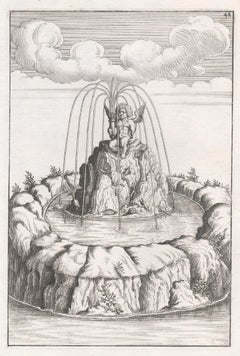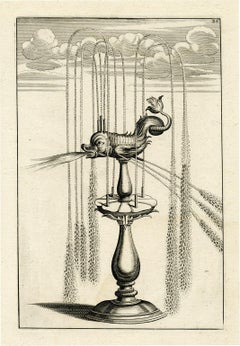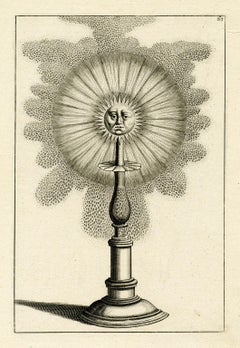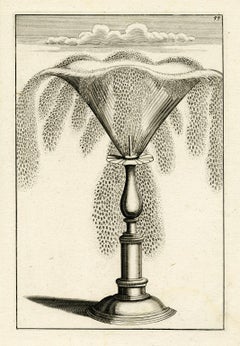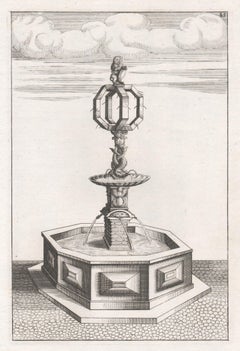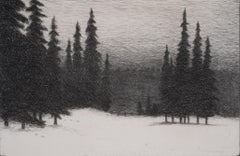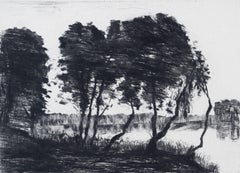Georg Andreas Böckler Prints and Multiples
German, 1617-1687
Georg Andreas Böckler was a German architect, engineer, and author. He was the architect of the city of Nuremberg and specialized in hydraulic architecture. Architectura Curiosa Nova was his main opus, a four-part work in one volume, published in 1664. In 1661, Böckler wrote Theatrum Machinarum Novum, an important work on windmills, pumps and other hydraulic machines. Böckler died in Ansbach.to
6
Overall Width
to
Overall Height
to
6
1,220
962
927
835
6
6
4
4
4
2
2
2
2
1
1
1
1
6
3
3
Artist: Georg Andreas Böckler
Baroque 17th century German fountain design engraving print by Boeckler
By Georg Andreas Böckler
Located in Melbourne, Victoria
Baroque 17th century German fountain design
Copper-line engraving, published in 1664 in Nuremberg. From 'Architectura Curiosa Nova' by George Andreas B...
Category
Mid-17th Century Baroque Georg Andreas Böckler Prints and Multiples
Materials
Engraving, Etching
Baroque 17th century German fountain design engraving print by Boeckler
By Georg Andreas Böckler
Located in Melbourne, Victoria
17th century German fountain design
Copper-line engraving, published in 1664 in Nuremberg. From 'Architectura Curiosa Nova' by George Andreas Beckley (...
Category
Mid-17th Century Baroque Georg Andreas Böckler Prints and Multiples
Materials
Engraving, Etching
Architectura Curiosa Nova, Dragon Fish Garden Fountain
By Georg Andreas Böckler
Located in Myrtle Beach, SC
George Andreas Böckler, 'Dragon Fish Garden Fountain', antique copperplate engraving, 1664, from the book 'Architectura Curiosa Nova'. A fine, richly in...
Category
1660s Realist Georg Andreas Böckler Prints and Multiples
Materials
Engraving
Architectura Curiosa Nova, Sunburst Garden Fountain
By Georg Andreas Böckler
Located in Myrtle Beach, SC
George Andreas Böckler, 'SunBurst Garden Fountain', antique copperplate engraving, 1664, from the book 'Architectura Curiosa Nova'. A fine, richly inked...
Category
1660s Realist Georg Andreas Böckler Prints and Multiples
Materials
Engraving
Architectura Curiosa Nova, Chalice Garden Fountain
By Georg Andreas Böckler
Located in Myrtle Beach, SC
George Andreas Böckler, 'Chalice Garden Fountain', antique copperplate engraving, 1664, from the book 'Architectura Curiosa Nova'. A fine, richly inked ...
Category
1660s Realist Georg Andreas Böckler Prints and Multiples
Materials
Engraving
Baroque 17th century German fountain design engraving print by Boeckler
By Georg Andreas Böckler
Located in Melbourne, Victoria
Baroque 17th century German fountain design
Copper-line engraving, published in 1664 in Nuremberg. From 'Architectura Curiosa Nova' by George Andreas B...
Category
Mid-17th Century Baroque Georg Andreas Böckler Prints and Multiples
Materials
Engraving, Etching
Related Items
“Skogskanten” (Winter Landscape with Spruce Trees)
Located in Stockholm, SE
Oskar Bergman (Stockholm 1879–1963 Saltsjöbaden)
“Skogskanten” (Winter Landscape with Spruce Trees)
signed "Oskar Bergman" in pencil
drypoint etching
image size: 19.5 x 29.5 cm (7 ...
Category
1910s Naturalistic Georg Andreas Böckler Prints and Multiples
Materials
Paper, Drypoint, Etching
Trees on the Shore of Grunewaldsee, from: Berlin Impressions - German Berlin
By Lesser Ury
Located in London, GB
This original etching and drypoint is hand signed in pencil by the artist "L. Ury" at the lower left margin.
It is numbered 20 from the standard edition of 100. There was also an edi...
Category
1920s Impressionist Georg Andreas Böckler Prints and Multiples
Materials
Drypoint, Etching
$2,100
H 14.02 in W 10.52 in
The West Prospect of the Cathedral of York /// "Britannia Illustrata" Engraving
By Johannes Kip
Located in Saint Augustine, FL
Artist: Johannes "Jan" Kip (Dutch, 1652/3-1722)
Title: "The West Prospect of the Cathedral of York" (Vol. 3, Plate 31)
Portfolio: Britannia Illustrata / Le Nouveau Théâtre de la Grande Bretagne
Year: 1715-1724 (Third edition)
Medium: Original Engraving and Etching on cream laid paper
Limited edition: Unknown
Printer: Joseph Smith, London, UK
Publisher: Joseph Smith, London, UK
Reference: "London Illustrated 1604-1850" - Adams No. 22; Crace No. 201; Brunet IV No. 114; Lowndes No. 1277; Lewine page 263-264
Sheet size: 19.25" x 24.19"
Image size: 16.75" x 22.5"
Condition: With centerfold as issued. Some light toning and foxing mainly in margins, and some light edgewear. Has been professionally stored away for decades. It is otherwise a strong impression in very good condition
Rare
Notes:
Provenance: private collection - Ross-on-Wye, UK. Engraved by Dutch artist Johannes "Jan" Kip (1652/3-1722) after a drawing by Dutch artist Leonard Knyff or Leendert Knijff (1650-1722). Comes from Kip's six volume (including Supplement and 'Atlas Anglois') "Britannia Illustrata" / Le Nouveau Théâtre de la Grande Bretagne", (1724-1728) (Third edition), which consists of 394 engravings and etchings. Printed in one color from one copper plate: black.
Biography:
Johannes "Jan" Kip (1652/53 in Amsterdam - 1722 in Westminster) was a Dutch draftsman, engraver and print dealer. Together with Leonard Knyff, he made a speciality of engraved views of English country houses.
Kip was a pupil of Bastiaen Stopendaal (1636–1707), from 1668 to 1670, before setting up on his own; his earliest dated engravings are from 1672. In April 1680, at the age of 27, he married Elisabeth Breda in Amsterdam. After producing works for the court of William of Orange in Amsterdam, Kip followed William and Mary to London and settled in St. John Street in Farringdon, where he conducted a thriving printselling business. He also worked for various London publishers producing engravings after such artists as Francis Barlow (c. 1626–1704) and Caius Gabriel Cibber (1630–1700), largely for book illustrations. He made several engraved plates for Awnsham & John Churchill's "A Collection of Voyages & Travels" (first published 1704). He signed the African scenes in volume V of the 1732 edition as "J. Kip".
His most important works were the large fold-out folio illustrations for "Britannia Illustrata", 1708; for the 65 folio plates he engraved for the antiquary Sir Robert Atkyns, "The Ancient and Present State of Glostershire", 1712 (1st edition); and for "Le Nouveau Théâtre de la Grande Bretagne ou description exacte des palais de la Reine, et des Maisons les plus considerables des des Seigneurs & des Gentilshommes de la Grande Bretagne", 1715, an extended reprint in collaboration with other artists.
The linked careers of Jan Kip and Leonard Knyff made a specialty of engraved views of English country houses, represented in detail from the bird's-eye view, a pictorial convention for topography. Their major work was "Britannia Illustrata: Or Views of Several of the Queens Palaces, as Also of the Principal seats of the Nobility and Gentry of Great Britain, Curiously Engraven on 80 Copper Plates", London (1707, published in the winter of 1708–9). The volume is among the most important English topographical publications of the 18th century. Architecture is rendered with care, and the settings of parterres and radiating avenues driven through woods or planted across fields, garden paths, gates and toolsheds are illustrated in detail. The images are staffed with figures and horses, coaches pulling into forecourts, water...
Category
1720s Old Masters Georg Andreas Böckler Prints and Multiples
Materials
Laid Paper, Engraving, Etching, Intaglio
Benevolent Cottagers /// English Landscape Figurative Village Scene Engraving
Located in Saint Augustine, FL
Artist: (after) Sir Augustus Wall Callcott (English, 1779-1844)
Title: "Benevolent Cottagers"
Year: 1816
Medium: Original Etching and Engraving on laid paper
Limited edition: Unknown...
Category
1810s Old Masters Georg Andreas Böckler Prints and Multiples
Materials
Engraving, Etching, Laid Paper, Intaglio
$600
H 20.75 in W 15.5 in
Veduta del Romano Camipidpglio con scalinata che va alla chisea d’Araceli (The C
By Giovanni Battista Piranesi
Located in Fairlawn, OH
Veduta del Romano Camipidpglio con scalinata che va alla chisea d’Araceli (The Capitol and the Steps of S. Maria in Aracoeli)
Etching, 1775
Watermark: Double Circle Fleur de Lys
A lifetime impression with the price etching in the plate
Printed in Rome, before the plates are moved to Paris and the numerous posthumous editions
Reference: Hind 38 ii/IV
Robison 38 ii/V with the price
Wilton Ely 190
Condition: A fine Roman...
Category
1770s Baroque Georg Andreas Böckler Prints and Multiples
Materials
Etching
$2,500
H 15.75 in W 21.375 in
Thorsby House in the County of Nottingham /// "Vitruvius Britannicus" Engraving
By Colen Campbell
Located in Saint Augustine, FL
Artist: Colen Campbell (Scottish, 1676-1729)
Title: "Thorsby House in the County of Nottingham" (Vol. 1, Plate 91)
Portfolio: Vitruvius Britannicus; or The British Architect, Contain...
Category
1710s Old Masters Georg Andreas Böckler Prints and Multiples
Materials
Laid Paper, Engraving, Etching, Intaglio
Powis House in Ormond Street London /// "Vitruvius Britannicus" Engraving
By Colen Campbell
Located in Saint Augustine, FL
Artist: Colen Campbell (Scottish, 1676-1729)
Title: "Powis House in Ormond Street London" (Vol. 1, Plate 42)
Portfolio: Vitruvius Britannicus; or The British Architect, Containing th...
Category
1710s Old Masters Georg Andreas Böckler Prints and Multiples
Materials
Laid Paper, Engraving, Etching, Intaglio
$425
H 13.82 in W 21.32 in
Crab Boats, Southampton Water /// Impressionist British Seascape Ship Maritime
By Aileen Mary Elliot
Located in Saint Augustine, FL
Artist: Aileen Mary Elliot (English, 1896-1966)
Title: "Crab Boats, Southampton Water"
*Signed by Elliot in pencil lower right
Circa: 1925
Medium: Original Drypoint Etching on laid p...
Category
1920s Modern Georg Andreas Böckler Prints and Multiples
Materials
Laid Paper, Drypoint, Etching, Intaglio
Royal Hospital att Greenwich to the River /// "Vitruvius Britannicus" Engraving
By Colen Campbell
Located in Saint Augustine, FL
Artist: Colen Campbell (Scottish, 1676-1729)
Title: "Royal Hospital att Greenwich to the River" (Vol. 1, Plates 86, 87)
Portfolio: Vitruvius Britannicus; or The British Architect, Co...
Category
1710s Old Masters Georg Andreas Böckler Prints and Multiples
Materials
Laid Paper, Engraving, Intaglio, Etching
Adrian Collaert Martin de Vos 17th Century Engraving Annunciation of Our Lady
By Adriaen Collaert
Located in London, GB
We have the full series of 52 prints (including title page) from Vita Passio et Resurrectio Iesu Christi listed. To find the others scroll down to "More from this Seller" and below i...
Category
17th Century Realist Georg Andreas Böckler Prints and Multiples
Materials
Engraving
Salvador Dalí -- Place Furstenberg
By Salvador Dalí
Located in BRUCE, ACT
Salvador Dalí
Place Furstenberg, 1971
Drypoint etching
Hang signed lower right
Numbered 55/250 lower left
Image size 31.5 x 38.5 cm
Sheet size 50 x 64 cm
Printed by Moret
Publisher...
Category
1970s Georg Andreas Böckler Prints and Multiples
Materials
Drypoint, Etching
17th century engraving black and white landscape ancient building scene
By Israel Silvestre
Located in Milwaukee, WI
In the mid-seventeenth century, views of historic landscapes and classical structures were increasingly popular among print collectors, and artists like the Frenchman Israel Sylvestre were eager to fill that demand. In this example, Sylvestre captures a view of the Arch of Constantine...
Category
Mid-17th Century Baroque Georg Andreas Böckler Prints and Multiples
Materials
Engraving
$1,950
H 11.25 in W 14.25 in
Georg Andreas Böckler prints and multiples for sale on 1stDibs.
Find a wide variety of authentic Georg Andreas Böckler prints and multiples available for sale on 1stDibs. You can also browse by medium to find art by Georg Andreas Böckler in engraving, etching and more. Not every interior allows for large Georg Andreas Böckler prints and multiples, so small editions measuring 7 inches across are available. Customers who are interested in this artist might also find the work of George Biddle, Peter Handel, and Candida Hofer. Georg Andreas Böckler prints and multiples prices can differ depending upon medium, time period and other attributes. On 1stDibs, the price for these items starts at $165 and tops out at $325, while the average work can sell for $245.

